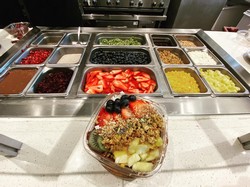The mecca of college students may not be multi-story brick academic buildings or residence halls where you can hear the near-constant chatter of students. For many students, it’s the on-campus dining facilities, where they receive the nourishment they need to power through seemingly endless lectures and all-nighters in the library.
However, nourishment may not exactly be the correct term. Everyone’s heard the legend of the infamous and dreaded “freshman fifteen.” The rite of passage for first-year students is often a few extra pounds due to unhealthy choices at on-campus dining facilities.
Does this have to be the case? Executive Chef, Steve Roland of Gourmet Dining at Monmouth University, would say no. According to Roland, an array of nutrient-dense, healthy options can be found throughout campus eateries. This includes the Rebecca Stafford food court and Magill Commons dining hall.
Within the dining hall, seasonal fruit, yogurt, and oatmeal are available daily for breakfast, the coined “most important meal of the day.” For those looking for a heartier option, egg whites are available at the omelet station. As for lunch and dinner, the “Chef’s Table” always has two vegetable options and a starch that can be paired with the two available entrees. There is even a daily vegan option.
Roland said, “Many of our vegan options are made with grains and legumes.” According to the National Library of Medicine, a high intake of grains and legumes is associated with a lower risk for conditions such as heart disease, high blood pressure, stroke, and Type 2 Diabetes. Roland noted that for students who are keeping track of their macronutrient intake, nutrition labels are provided for each meal with approximate calorie and carb counts.
The food court offers some more creative options for those keeping nutritional value in mind. There is a salad station, where students can build their own salad filled with a variety of veggies, proteins, fun toppings, and dressings. There’s even a Mexican-inspired station called Sonos, where students can get an “ensalada bowl.” Students have the choice of replacing a bag of chips with a piece of fruit on the side of their meal.
Skylar Paletta is a health studies and exercise science student at the University. She also is a certified personal trainer. As a student who used on-campus dining facilities for two years, she was a huge fan of options in the food court, especially as a way to help her reach her fitness goals. She said, “I found it was easier to eat here as I could control what was going into my salad or burrito bowl. For example, you can’t go wrong with some brown rice, protein, and some toppings.”
What helped Paletta stay on track was planning out her meals on a daily basis. For her, this meant looking at the menu to decide what she wanted before she got to to the dining facility. “This way, I knew that my eyes weren’t going to be bigger than my stomach, and I would stick with the healthiest, most nutritious options to power me through my day,” she said.
Stephany Ayoubi is a registered dietician with her master’s degree in nutrition and food science. She also teaches nutrition courses to undergraduates at the University. Ayoubi recommends that students include a serving of protein with every meal, whether it be animal or plant-based. She suggests consuming between four and eight ounces of protein at mealtimes, depending on personal needs and body type.
Ayoubi also encourages students to balance their plates by including a vegetable with each meal, as well as a complex carb. She noted that these can be found in abundance at the dining hall’s hot bar, usually in the form of rice, quinoa, and potatoes. Complex carbs are a great source of energy for students with a heavy workload and extensive schedule.
Ayoubi also stressed the importance of timing meals. She suggests that students eat every three to four hours and take their time consuming their food. She said, “Allow yourself about 15-30 minutes to enjoy your meal and catch up with friends when possible. Rushing to eat in a hurry will not give your brain enough time to process that it feels full…it takes about 20 minutes for the brain to release signals of satiety.”
Something that both Paletta and Ayoubi stressed was the importance of balance. Paletta emphasized the idea that restriction is never productive when it comes to eating. She said, “My number one tip when it comes to eating is to not be too hard on yourself. It is completely normal to have a huge bowl of pasta one day or an ice cream sundae.”
Ayoubi said, “It’s all about balance at the end of the day.” Something that she enjoys doing as a way of treating herself is keeping a square of dark chocolate in her lunch box as a way to boost her blood sugar and listen to cravings in a “mindful way.”
It seems as though the University values the health of its students and works hard to accommodate the needs of those who dine on campus. By practicing balance, mindful eating, and sound decision-making, the freshman fifteen can remain a folktale for students. Paletta said it best, “We are lucky to be going to Monmouth, where there are so many options regardless of your dietary preferences.”
IMAGE TAKEN from Gourmet Dining at Monmouth University (Facebook)




